► Porsche’s first production electric car
► Turbo and Turbo S focus on performance
► UK drive and in-depth review
There’s no doubt the Porsche Taycan Turbo and Turbo S have been instrumental in giving the Taycan the fully deserved reputation of the best all-electric super saloon. Now an established presence on the street, it’s not short of rivals; you may even consider it instead of something with an engine, as our Taycan vs M5, Polestar 1 and Tesla Model S group test explores.
When it burst onto the scene in 2019, it became the first electric car to seriously challenge the Tesla Model S in performance, desirability and usability whilst proving far more entertaining to drive. The Porsche Taycan is, to put it simply, everything we’d hoped for from Porsche’s first EV.
It has become a full range, including the less powerful Porsche Taycan 4S and RWD Taycan, and the practical Taycan Sport Turismo and Cross Turismo. The Turbo obviously lacks forced induction, but with up to 751bhp and 774lb ft as a Turbo S, it eclipses the numbers previously expected in a mainstream Porsche. Over 200 miles of range is possible, although in our experience only in ideal conditions.
Thankfully it also charges in half the time of a Tesla Model S (with some caveats, naturally) and debuted Porsche’s most technically stunning interior design to date. Quite a thing, then.
To find out more about the Porsche Taycan Turbo and Turbo S, keep reading our in-depth review.
Porsche Taycan Turbo S review

What’s so special about this Porsche Taycan?
It’s easy to get complacent about electric performance cars – they all seem to offer the same combination of a whacking great battery, two motors and about a million foot pounds of torque available from the drop of a hat.
The Taycan largely follows this brief, but introduced a key divergence: 800-volt power architecture, which is double that normally used in electric cars. Porsche trialled this tech in the Le Mans-winning 919 Hybrid race car. Other manufacturers are catching up, notably Hyundai and Kia, but it remains a significant factor in Porsche’s electric recipe. Naturally Audi’s e-Tron GT also offers 800V architecture, as it shares tech with the Taycan.
So what? Well, by increasing the voltage you can drop the current without affecting power output. Lower current means thinner cables, which in this case shaves about four kilograms off the loom. Most importantly it enables much faster charging times – still a stumbling block for electric cars.
In optimum conditions the Taycan has a peak charging capacity of 270kW, meaning you can pump 62 miles into the 93.4kWh battery in just five minutes, or go from 5 to 80% in just 22.5 minutes. It’s not quite as easy as that though, and we’ll get onto why later.
Best electric cars: CARs pick of the best EVs
Revealed: the fastest electric cars
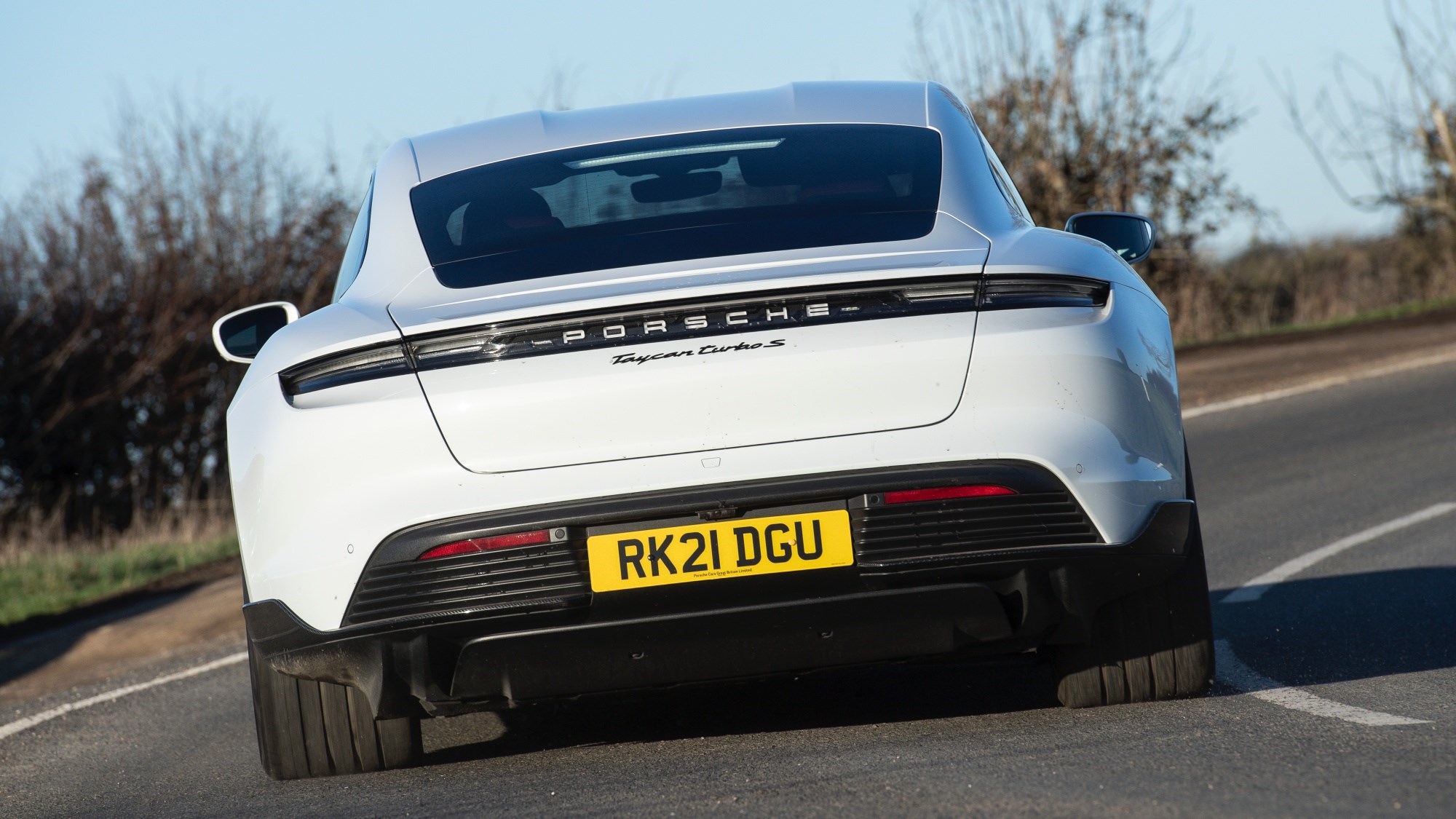
All this juice powers two electric motors (one on each axle, meaning all-wheel drive) which Porsche describes as ‘permanently excited’, like a toddler on Haribo, or the state of the motoring press since this car was revealed. It actually has something to do with magnets.
Finally the Taycan features a unique two-speed transmission on the rear axle (the front uses a more standard one-speed planetary gear) which means huge speed off the line and improved efficiency while cruising.
Huge speed! Now we’re talking!
First gear as described above is mainly present in Sport or Sport Plus driving modes, and particularly when you activate Launch Control. This is where the two Taycan Turbo models differ most – the regular Turbo with its 671bhp cracks 0-62mph in 3.2 seconds, and the 751bhp Turbo S in 2.8 seconds.
That’s fast for sure, but not, Ludicrously fast. The difference between this and a Tesla – says Porsche – is that the Taycan can do this over and over again until the frail organic mass behind the wheel has had enough.
But look – you’re not going to do repeated launch starts (unless you’re a motoring journalist on a lunch break) so this ability is all about A) Porsche showing off and B) putting a comparable figure on the Taycan’s sheer depth of performance.
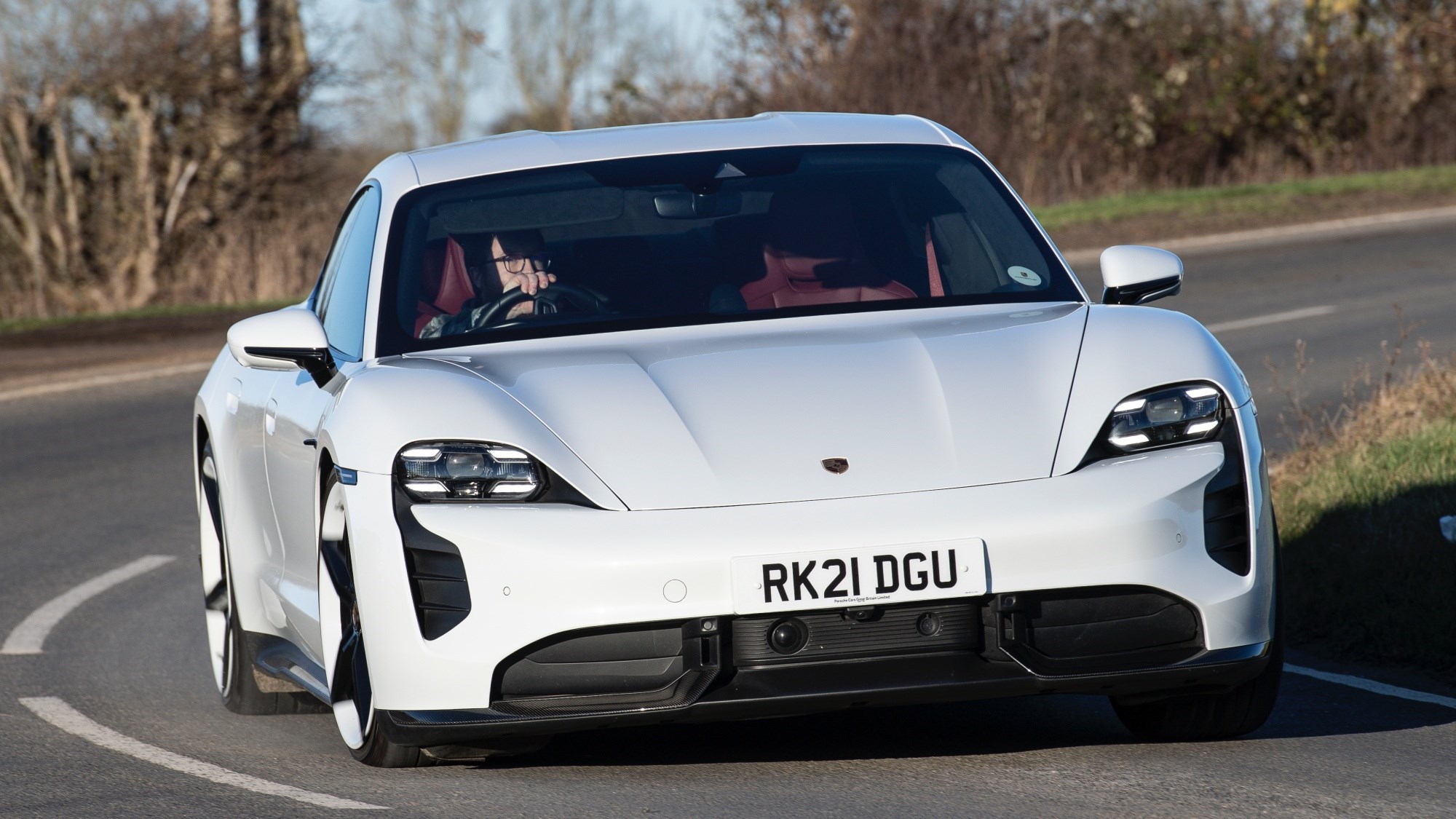
The theory being that if it can do those 2.8 second runs again and again it’ll have no problem at all accelerating out of the Stelvio Pass’s sequential hairpins, for example. Also, you wouldn’t use every last horse in something like a Ferrari 812 Superfast’s V12 – you pay all that money to know they’ll never run out, and it’s the same here. It’s about reserves.
What’s more interesting and useful in the real world is the 626- or 774-lbs ft of torque you get (depending on model) which punches the Taycan forwards with the sort of ferocity usually reserved for fighter pilots being catapulted off an aircraft carrier. You simply put your foot down and instantly find yourself somewhere else. There’s no turbo lag or waiting for the torque curve or any of that nonsense, just massive, retina detatching throttle response.
Thing is though, this is the same old story with every electric car, isn’t it? Even a Renault Zoe can catch other drivers out with its off-puttingly silent straight line performance, but they all fall apart the moment you try to get that weighty battery mass to turn in to a corner.
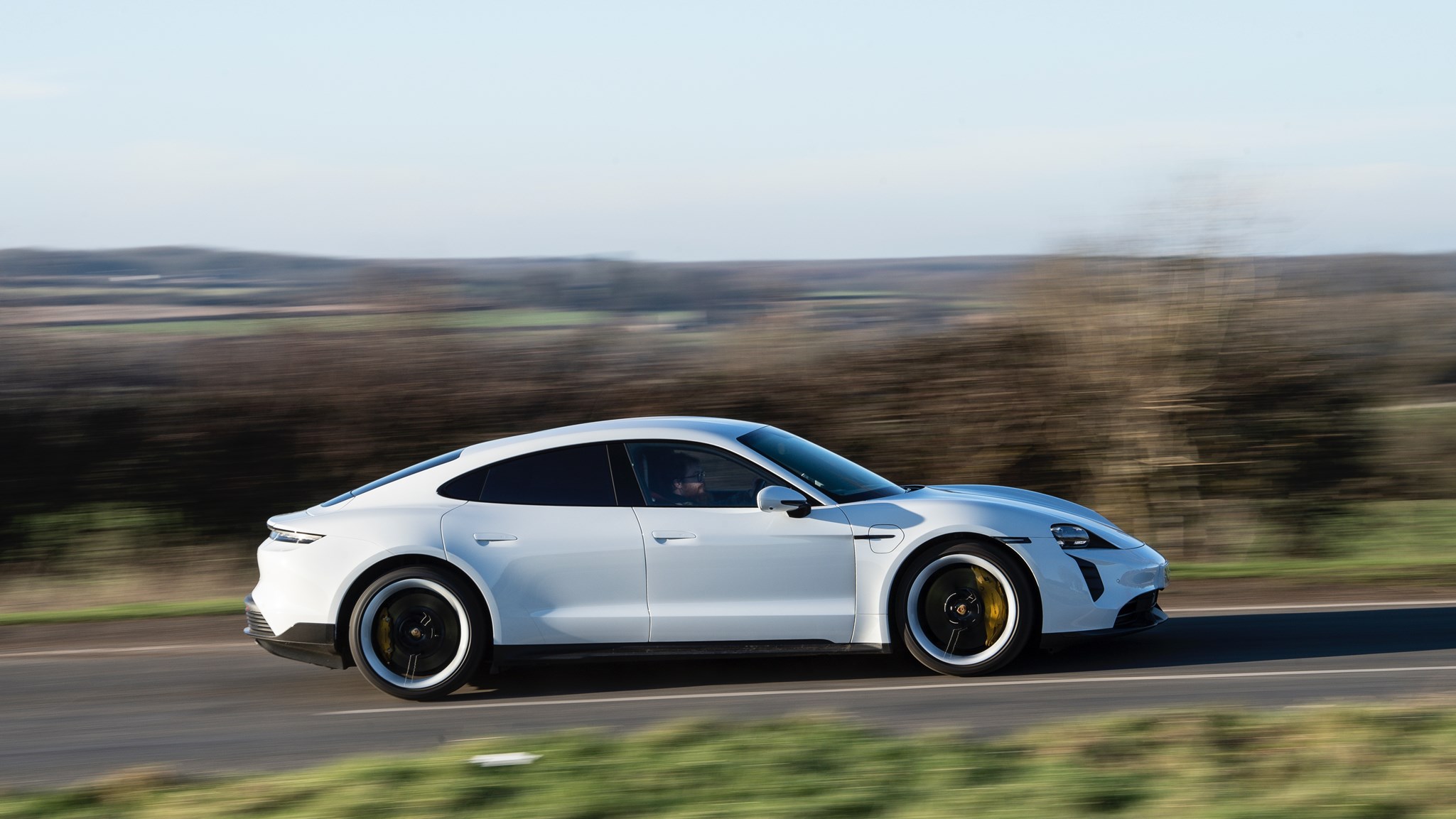
But this is a Porsche, so it’s different, right?
Yes and no – it’s not always silent for a start, because there’s a special engine noise generator (like the one in the Jaguar I-Pace) reserved for racier modes. It doesn’t sound like a Mezger but does as least give you a sense of what’s going on.
To address that kerbweight Stuttgart has thrown its entire arsenal of chassis tech at the Porsche Taycan Turbo S – but it’s not reinventing the wheel, these are all things we’ve experienced before – including all-wheel drive, torque vectoring, adaptive dampers, rear-wheel steering and electromechanical roll stabilisation. And these all communicate with each other using Porsche’s 4D Chassis Control to avoid conflicting inputs.
Hardware includes aluminium double wishbones up front and an aluminium multilink rear, plus three-chamber air suspension that can be raised to avoid speed bumps or lowered in two stages to improve grip and aero at high speed.
All of this can be tweaked in Sport Chrono cars using the now-typical steering wheel mounted drive mode selector, taking you through settings called Range, Normal, Sport and Sport Plus, plus an Individual configuration. Porsche says these offer the choice between long-distance wafting and high-precision handling, and we agree.
Despite the huge performance on tap the Taycan is actually lovely to waft around in – the 0.22cd drag coefficient makes this the slipperiest Porsche ever thanks to active aero and air suspension that can lower the car in two stages, and that means it’s quiet on a cruise save for the usual Porsche road roar. The Turbo with its smaller wheels is better than the noisier Turbo S in this instance, and it rides better too.
What’s the electric Porsche Taycan like to drive?
The spookiest thing of all is brought about by all that stuff in combination with the car’s naturally low centre of gravity – you’re acutely aware of the weight and as you turn into a corner and it makes you think, oh no, this thing is going to roll like a wheel of cheese on a Gloucestershire hillside the second you touch the steering, but then it turns in neatly and retains a flat body throughout. It shouldn’t corner like this.
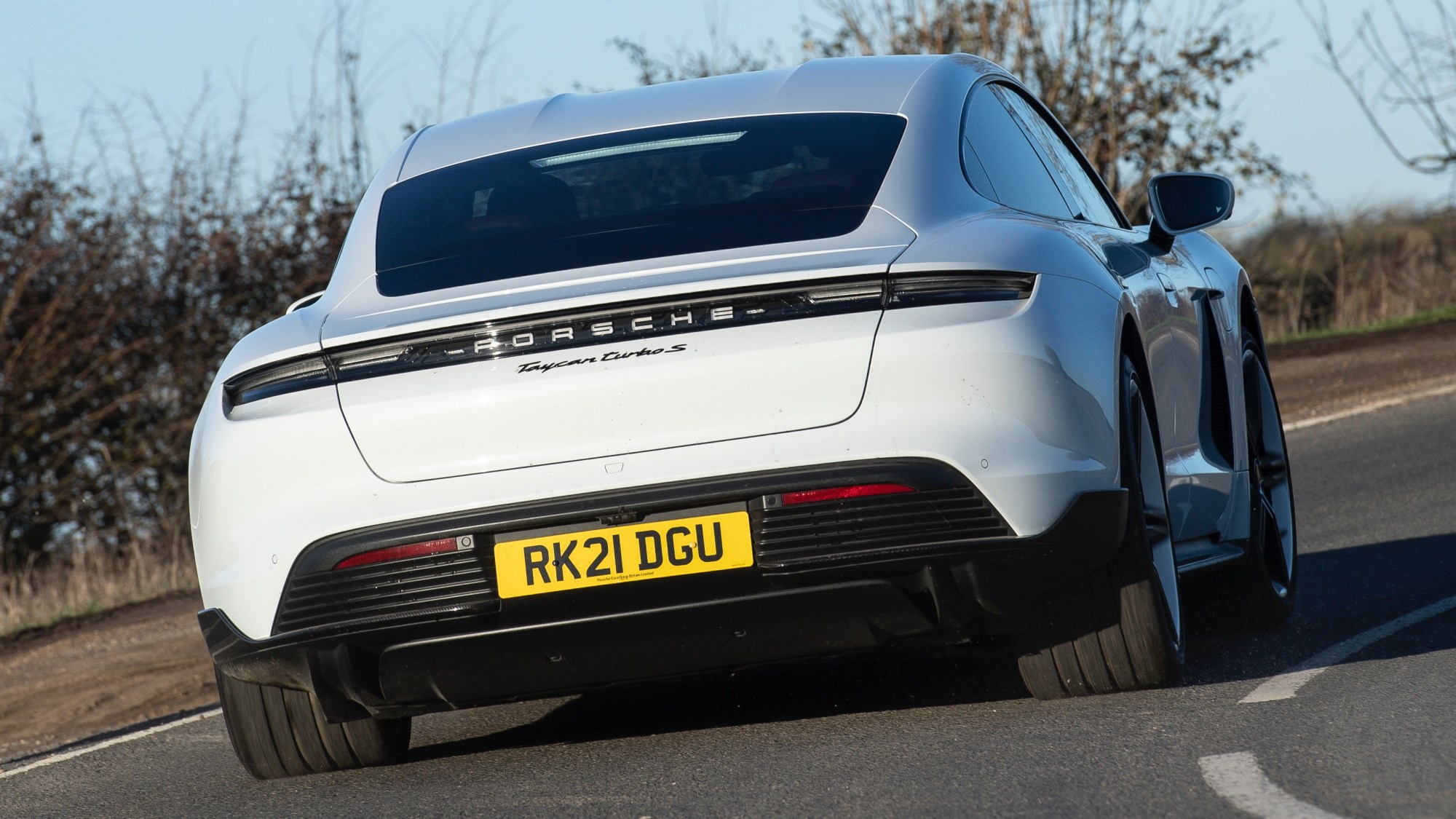
It also shouldn’t stop half as well as it does. A rolling mass weighing 2.3 tonnes should feel like it needs, say, a four-day weekend to slow from 70mph, but the Taycan manages it in barely a moment and usually does so without even needing to employ the mechanical brakes.
That’s because it can recoup 265kW through its regenerative system, much more than rivals, which means it can avoid using the discs in up to 90% of everyday braking. You have to push the pedal really quite hard and an awfully long way before the mechanical stoppers take over, which does make the tungsten carbide coating seem a bit needless, let alone the optional carbon ceramics. Porsche has even dated the service life of the brake pads – they must be replaced every six years, suggesting you could go all that time without wearing them out.
There’s also hardly any reduction of speed when you take your foot off the gas – much, much less than the one-pedal mode in a Nissan Leaf for example, resulting in an energy saving coast. Porsche says this is because maintaining momentum is more efficient than needlessly slowing the car down in order to generate a small amount of electricity. We’d like a little more regen, although there’s a special regeneration mode that uses both a forward facing camera and the sat-nav to slow you to appropriate level, rather than arbitrarily anchoring up. This works extremely well.
What’s the interior like?
In terms of size it’s somewhere between a 911 and Panamera, with decent rear seat space enhanced by special recesses in the battery under the floor in the rear called ‘foot garages’ that boost leg room while keeping the seating position low. Headspace is ok in the back but tall passengers will have to remove their hats – curiously it’s better in this sense when you spec the optional panoramic roof, which adds a few inches of room.
Behind the wheel and you’ll notice that the Taycan is started with a big on/off button like an appliance, not a key or a starter switch on the steering column like a car. The newer-style diminutive gearshifter is now mounted on the dashboard, freeing up space in the centre console, which takes a bit of getting used to.
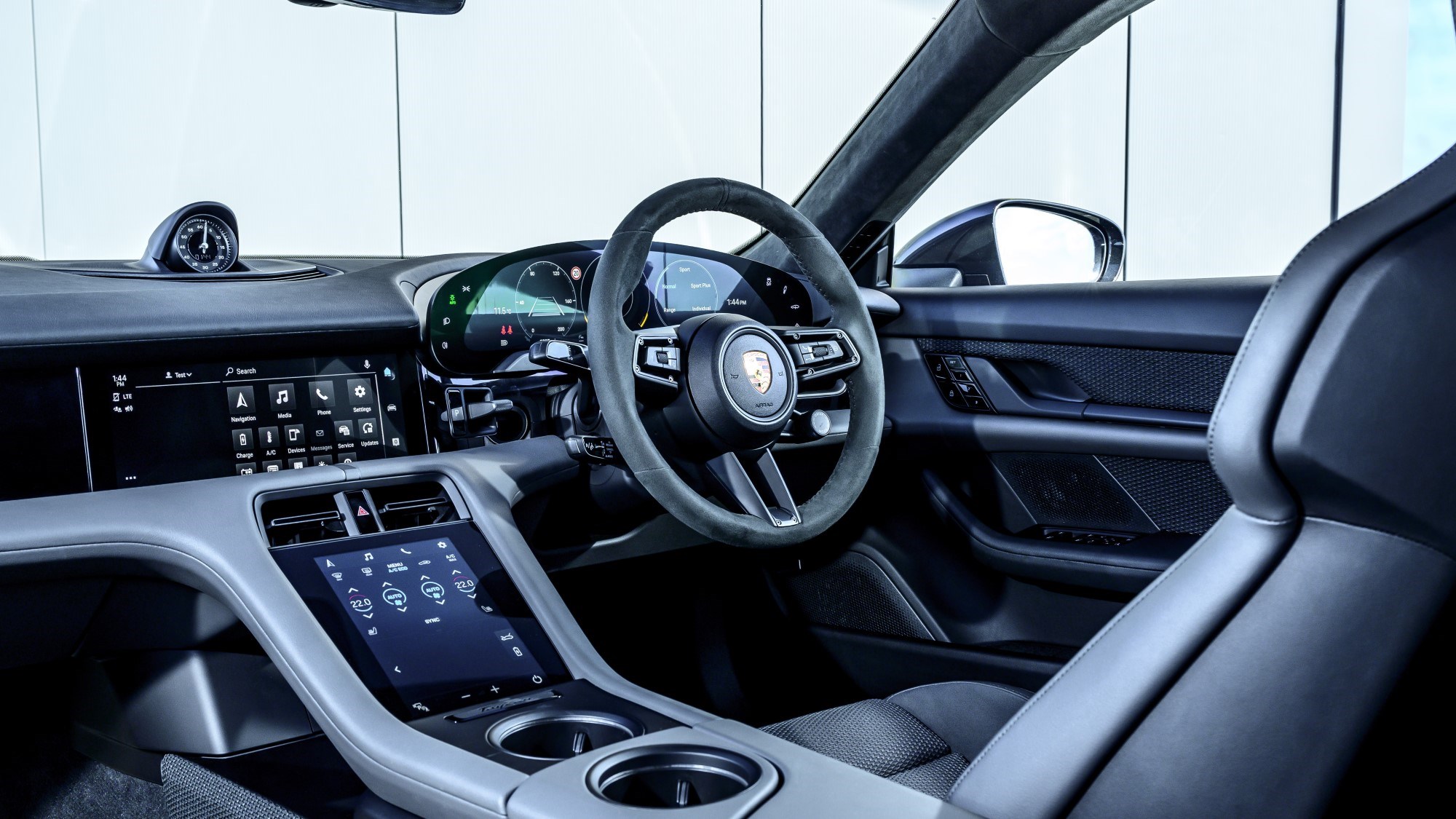
Porsche says the Taycan’s dashboard takes its cues from the original 911’s cleanly styled item from 1963 – in so much as there are very few buttons and the new free-standing instrument cluster is wider than the steering wheel. That’s where the two cars start to diverge, though.
The dials are displayed on a cowl-free, 16.8-inch curved digital screen with touch controls for things like the lights and damper mode along the edge. The main infotainment screen measures 10.9-inches and there’s an optional supplementary display, so you can get the front seat passenger to programme the sat-nav or choose which music to play, and so on. This means there’s a door-to-door swathe of black plastic which looks very cool, although it’s interrupted by breaks between the screens, annoyingly.
Below all of this there is another 8.4-inch touch panel for the air-conditioning controls and a notepad for entering addresses and things into the sat-nav, and if you spec the optional four-zone climate control then another 5.9-inch touch panel gets installed for rear seat passengers.
Some other curiosities – there are no mechanically operated louvres for the air vents, you now control the air flow from the climate screen (like a Tesla Model 3) and there’s a choice of leather tanned by olives or a completely hide-free interior complete with flooring made from old recycled fishing nets.
Anything else I should know?
As alluded to earlier that super-fast, 270kW charging is not widespread, though the number of 800v stations in the UK is expanding rapidly. Ionity (the old guard’s equivalent of the Supercharger network) has over 1800 high-power charging stations across Europe, and these are part of the Porsche Charging Service that gives Taycan owners three years of free support and discounted rates (which you’ll want to take advantage of, as Ionity chargers are pricey). Beyond those Ionity chargers, it’s best (albeit cheeky of Porsche) to pay for the 150kW on-board DC-DC converter to make the best use of the UK and Europe’s charging network.
All this al fresco charging-chat is mostly academic anyway because Porsche reckons 80% of fill ups will be done at home – ideally via a 11kWh wallbox where it’ll take about nine hours, but that requires digging your driveway up to install a three-phase supply, so in reality a 7.2kW job will have to do.
It’s quite an expensive car too, again positioned neatly between the 911 and Panamera, and quite a bit more than a Tesla Model S.
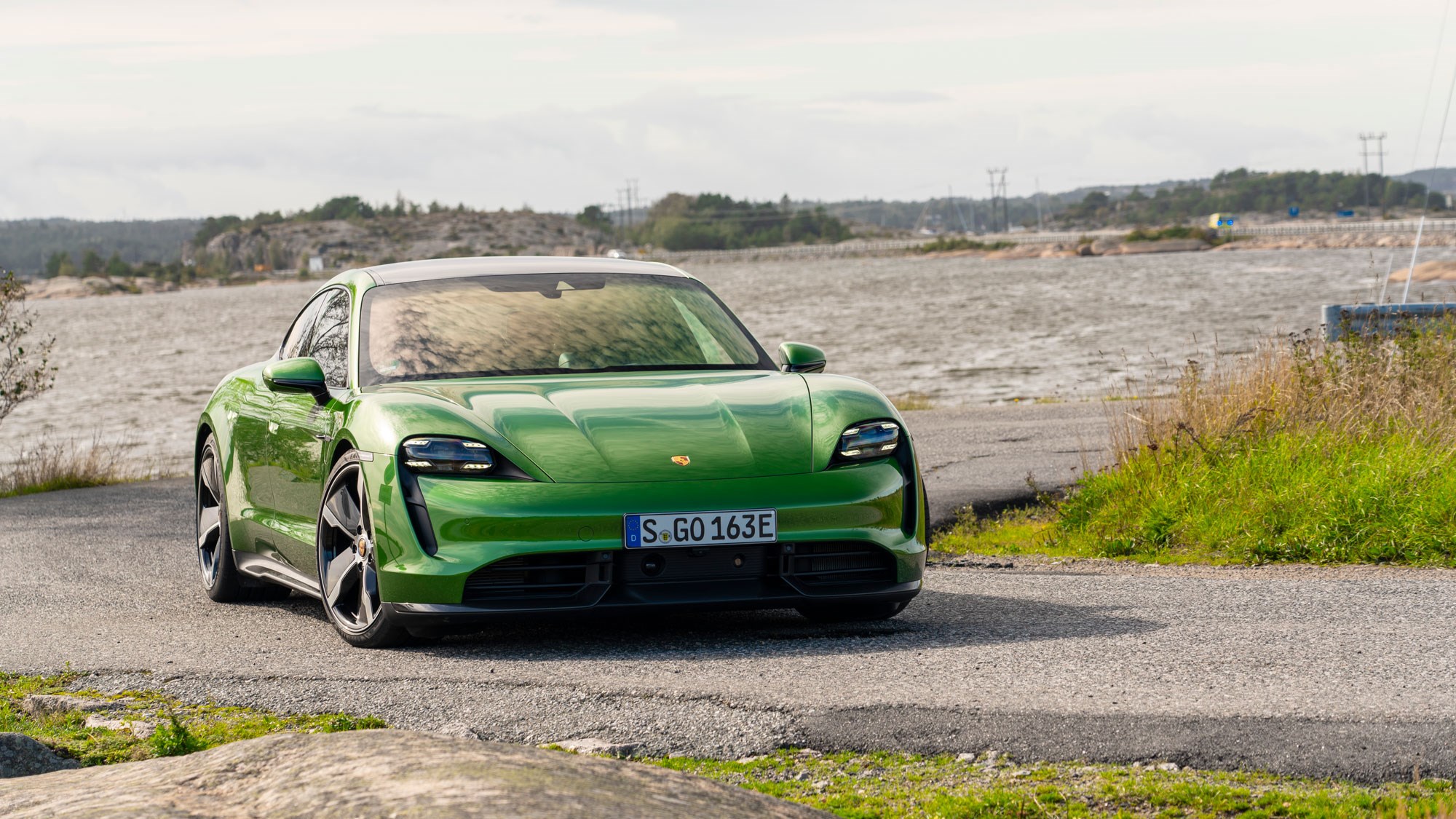
What about the standard Porsche Taycan Turbo?
The Porsche Taycan Turbo is spearing away from Silverstone circuit, the optional Electric Sport Sound swelling the whine of the zero emissions drivetrain to a shrill crescendo. I glance at the digital dials and see the Turbo, propelled by an electric motor on each axle, has effortlessly surged way past the speed limit.
About 15 minutes earlier, driving a Tesla Model 3 Performance along this same stretch of road I found its acceleration breath-taking, but the Taycan Turbo feels even more relentlessly rapid. Time to brake big time.
And my word, it’s a trademark Porsche front end. The 20-inch Pilot Sport tyres bite into the road surface and never threaten to let go, jinked left and right with millimetric precision by the delicate, responsive steering.
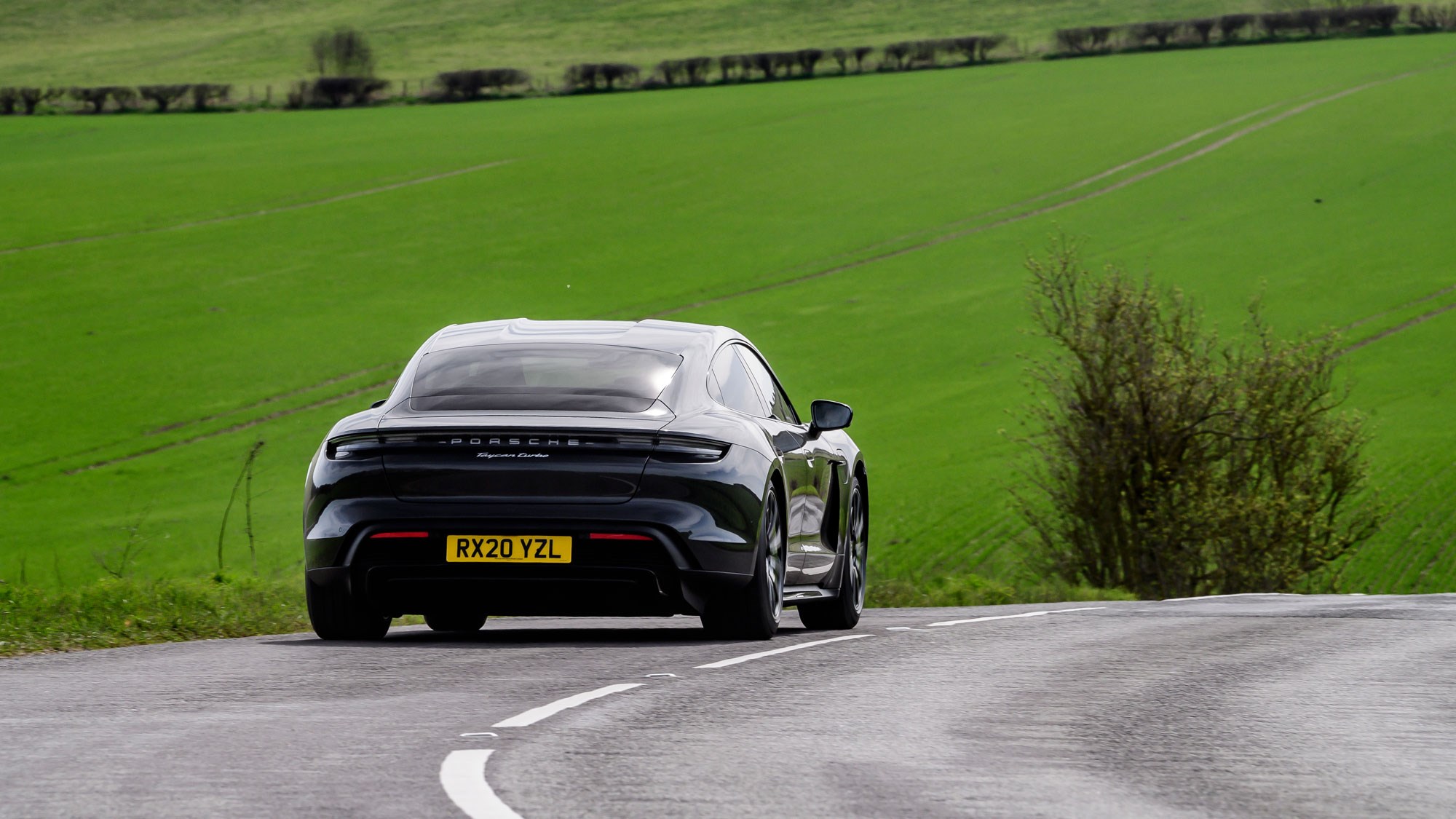
Back off in Normal mode and ride comfort is surprisingly compliant and noise well-suppressed on the brutal rural B-roads used in our European Car of the Year test day. The Porsche came a creditable third in the contest, quite an achievement considering the £116,625 Turbo is roughly £100k more expensive than the superminis also shortlisted by 60 jurors from across the continent.
The Turbo has the same 93.4kWh battery stack as the Turbo S, and the same 614bhp power output. But when you’re going for it in Performance mode, the Turbo’s overboost power and torque are reduced compared with the Turbo S’s – twist action is down by 148lb ft in fact, around what a modern three-cylinder turbo would produce in total.
As a result the Turbo is four-tenths slower to 62mph from standstill – only managing a stately 3.2secs – and its 10.6secs blast on to 124mph (200kmh) concedes 0.8sec. Yeah, you’re not missing out too much.
What’s the range for the Porsche Taycan Turbo S?
Both Turbo models can accept a mighty 270kW charge if you can find such a potent source; a base performance battery Taycan 4S is limited to 225kW and a smaller, 79.2kWh pack. One area the Turbo does outperform the Turbo S is in its WLTP-verified range of up to 280 miles (up almost 10 per cent) – though you’ll get nowhere near it if you frequently unlock the Taycan’s potential.
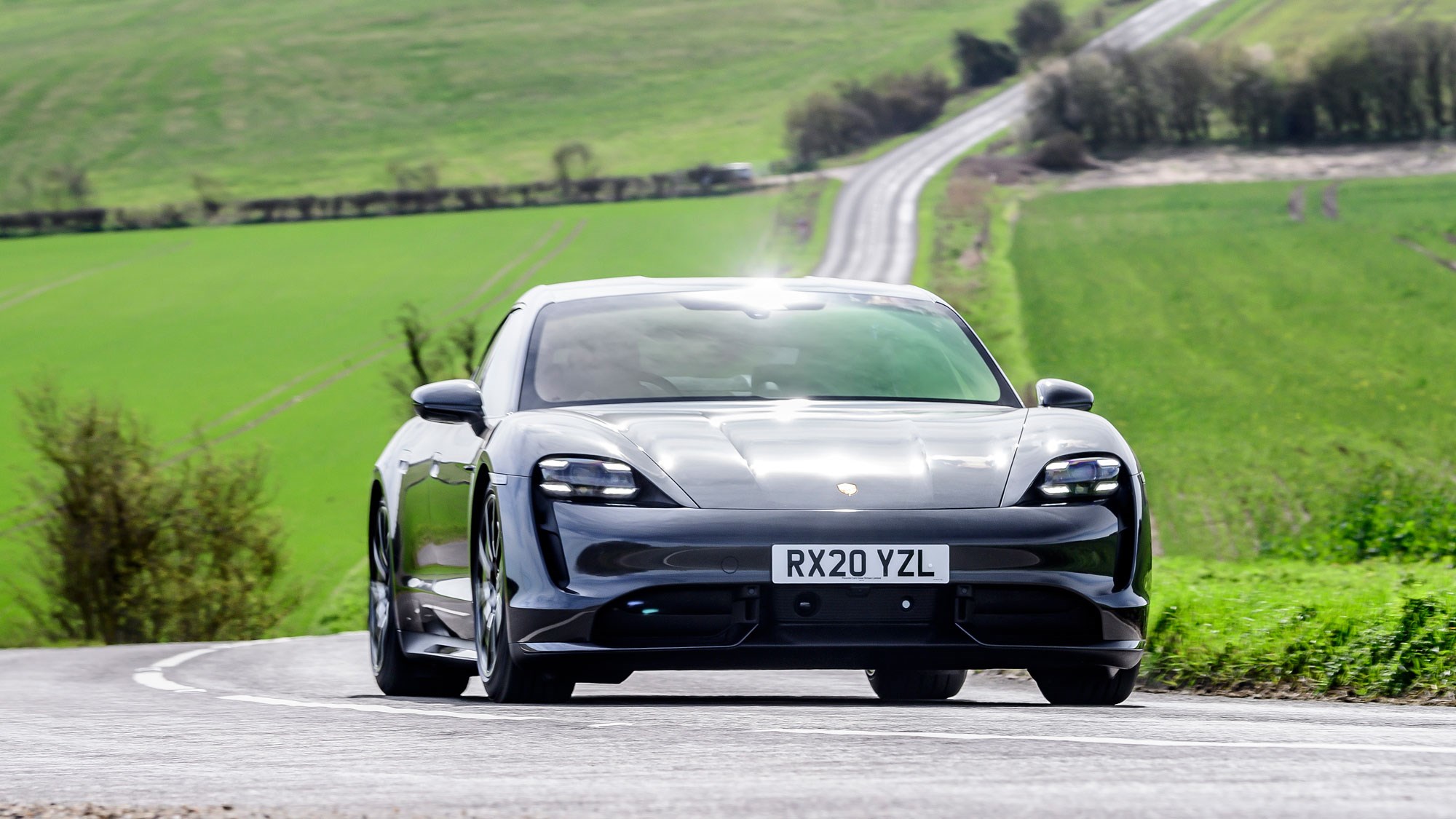
Instead you can cruise efficiently around enjoying the coupe’s responsiveness and agility, comfort and quiet, quality and lashings of tech – safe in the knowledge it will go like a pure Porsche the second the opportunity arises.
Verdict
The Porsche Taycan Turbo S is an incredible technical achievement. It does the things we all enjoy about driving – accelerating, braking, going around corners – with supreme alacrity, and features a massive well of capability largely untapped by normal driving. However, considering most will barely ever use the performance available, a lesser Taycan will make more sense for most.
While the whirr of electric propulsion feels robotic compared to a living, breathing combustion engine, this Porsche with its combination of brutal performance and agile handling moves the game on considerably by adding a bit of personality into the mix. Like Arnold Schwarzenegger in Terminator 2 after he’s learned to smile and say ‘hasta la vista’.
Plus with petrol-engined cars becoming increasingly sanitised by turbos and particulate filters and autonomy the void between EVs and the philosophical ideal sports car is considerably tighter than you’d expect. And the Taycan closes that gap further still.